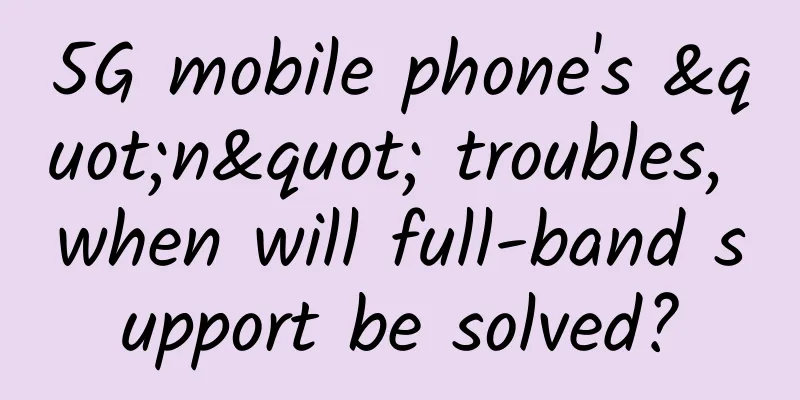5G mobile phone's "n" troubles, when will full-band support be solved?

|
Regarding the troubles of 5G mobile phones in frequency bands, the most memorable thing is probably Lei Jun's n79 frequency band theory, which triggered a war of words among some mobile phone manufacturers on the Internet, where they hated others for having them and laughed at others for not having them. However, to this day, 5G mobile phones are still suffering from the trouble of incomplete frequency bands, and even the frequency bands supported by global brands in their products are different. This has also caused "n" troubles for some potential 5G mobile phone consumers. The "n" troubles of 5G mobile phone users At present, in the international market, the most obvious frequency band missing of some mobile phones is the lack of support for millimeter wave bands. Among the newly released new products, manufacturers generally choose the strategy of supporting millimeter waves for top flagships and not supporting standard flagships. For example, the latest Samsung Galaxy S20 series, the S20 5G does not support millimeter wave bands, while the S20 Plus 5G and S20 Ultra 5G support n260 and n261. Sony's Xperia Pro supports millimeter wave n260 and n261, but Sony Xperia 1 II does not.
But what’s interesting is that some of the first batch of 5G mobile phones sold in the United States in 2019 chose to support the millimeter wave n260 and n261 frequency bands, but not the Sub-6GHz frequency band. The most representative ones are the LG V50 ThinQ 5G and Samsung Galaxy Note 10 5G sold by Verizon. In addition, there are the Moto 5G Mod (5G mobile phone case) and Samsung Galaxy S10 5G, which are pioneers in 5G in the US market. For the domestic market, since most international versions of mobile phones do not yet support China Mobile's n41 and n79, China Mobile's 5G users can only choose domestic versions of mobile phones when choosing 5G mobile phones. On the contrary, 5G users of China Unicom and China Telecom have already started to buy the Korean version of Samsung Galaxy S20 to use 5G. In addition, domestic mobile phone brands' products do not support millimeter wave frequency bands at present, which will not have any impact on domestic sales, after all, millimeter wave may be deployed in China in 2021. However, for Europe, the United States, Japan and South Korea, since the United States has begun to deploy millimeter wave in 2019, Europe, Japan and South Korea will deploy millimeter wave in 2020, not supporting millimeter wave frequency bands will obviously affect the competitiveness of products in the international market. In other words, if consumers want to buy a mobile phone that perfectly supports all frequency bands, can support the pace of operators' 5G network construction in the next two years, or can travel around the world without fear of 5G networks, it does not exist yet. Hardware support is no longer a problem Regarding this issue, the first thing that can be confirmed is that hardware technical support is no longer a problem. Among the mainstream models that have been released so far, the Xiaomi 10 series, Samsung Galaxy S20 series, and Sony Xperia series released in early 2020 all use the Qualcomm Snapdragon 865+X55 combination. The Redmi K30 5G, OPPO Reno 3 Pro 5G, and Realme X50 5G phones released in December 2019 use the Snapdragon 765G+X52 combination. Both X55 and X52 can support the Sub-6GHz and millimeter wave bands under the operators' 5G networks in 2020 and 2021. At the 2019 Snapdragon Technology Summit, Alex Katuzian, senior vice president and general manager of Qualcomm's mobile business, specifically emphasized at the launch of the Snapdragon 865 mobile platform that "the newly released Snapdragon 5G mobile platform is a truly global 5G solution." In fact, the Snapdragon X55 modem and RF system that works with the Snapdragon 865 mobile platform was a product for all 5G frequency bands and regions around the world when it was first released. The X52 was later officially confirmed to also support all current 5G frequency bands around the world. In addition, the Exynos 5123 baseband currently used with Samsung Exynos 990 also supports Sub-6GHz and millimeter wave frequency bands. Even for the future, the Snapdragon X60, which was just released in February, has begun to focus on how to better utilize various 5G frequency bands. One of its main features is that it supports carrier aggregation of Sub-6GHz and millimeter wave bands, and in the Sub-6GHz band, it can also support carrier aggregation of TDD and FDD, thereby greatly improving the daily usage rate of 5G terminals. Obviously, the more frequency bands a mobile phone supports, the better. This is also possible in terms of hardware technology. So where exactly is the "n" problem with mobile phones? Three reasons for worrying Perhaps the first reason for the difference between the versions of the Samsung Galaxy S20 series in different regions has been given: the operator. The S20 Plus 5G and S20 Ultra 5G that support n260 and n261 mentioned above are the versions sold in the United States, but the Korean version does not currently support the millimeter wave band. Due to the removal of the millimeter wave module, these two local phones are also 2g lighter than the US version. Samsung said that the choice of millimeter wave is determined by the 5G network conditions of each country, which is the result of Samsung's consultation with Korean operators.
In fact, it is not difficult to see from the above-mentioned frequency bands that only support millimeter waves that the decisive role of US operators is also obvious. Verizon has made all mobile phones support only millimeter waves, and has also continuously demonstrated the ultra-high peak rate under this frequency band in its publicity. Coincidentally, Deutsche Telekom is currently vigorously promoting the S20 5G model in the Samsung Galaxy S20 series in the US market. The feature of this model that only supports Sub-6GHz coincides with Deutsche Telekom's current low-band 5G strategy. However, this also leads to the second reason why current 5G mobile phones cannot support all frequency bands: design trade-offs. The biggest reason why the Galaxy S20 5G does not support the millimeter wave band may be that the millimeter wave antenna is not easy to fit in the case of small size and thickness. The internal space of mobile phones is becoming very expensive, especially the frame. Perhaps in 2021, when smaller antenna modules are available, 5G mobile phones will be able to fit more and support more frequency bands. The third reason may be found in the 2G that the Korean version of the S20 Plus 5G and S20 Ultra 5G has, which is cost. Since local operators have no demand, installing it in vain will undoubtedly increase costs, so it is better not to install it. So, when will the "n" troubles of 5G mobile phones be solved? Perhaps the deployment progress of global operators will give the answer. In 2020, the United States, Europe, China, Japan, South Korea and Australia will all build FDD 5G networks in Sub-6GHz (previously mostly TDD). In addition to the deployment of millimeter waves in Europe, Japan and South Korea in 2020, the 2022 Beijing Winter Olympics will also boost the commercial use of millimeter waves, and the ultra-high peak rate is also conducive to the application of new technologies in the arena. By then, on the one hand, global operators will build their own 5G networks more completely, and on the other hand, the technological development of related components in process, power consumption and volume will make it possible for the "n" troubles of 5G mobile phones to be completely solved. |
<<: iOS13.4beta5 experience sharing, 7P fluency has been improved
>>: How to clean your iPhone and AirPods? Apple's official tutorial is here
Recommend
One million vehicles recalled, sales down 34.8%, Dongfeng Nissan may no longer be "far ahead"
Dongfeng Nissan used to be a far-leading player i...
How to promote wedding photography? Mayu platform marketing and promotion strategy!
With the arrival of summer, the wedding photograp...
Forum community traffic diversion skills: How to get nearly 100,000 seed users in 8 hours at zero cost
Among the many promotional techniques, what I wil...
Anhui Self-study Network SEO Optimization Training Case
We made this website for a client. You can see th...
NetEase's secret to creating popular content!
How did NetEase achieve tens of millions of scree...
Is it really possible to resurrect dinosaurs?
Humans obtain dinosaur genetic fragments for the ...
Weibo has officially launched the V+ membership service. How is it operated and promoted?
On November 8, Weibo officially launched the V+ m...
Students use ChatGPT to do homework? Chinese professor posted on Natuer: Encourage, but do it this way
Source: Nature Original author: Hong Yang, Profes...
Mysterious green light detected in the atmosphere of Mars? What is the connection with the aurora?
Astronomers detect a fascinating green glow in Ma...
World Gut Health Day丨It is important to learn these healthy “gut knowledge”!
Expert of this article: Cheng KT, Master of Gener...
Behind the collective criticism from competitors: LeTV’s “buy a membership and get a TV for free” has changed the way the industry plays
April 14th, an originally ordinary day, has becom...
A new method to improve the survival rate of Android application processes (Part 1)
[[179902]] Basics Android process priority 1 Gene...
TikTok from 0 to 1 basic course
TikTok 0 to 1 Basic Course Resource Introduction:...
What are the functions of the Lanzhou WeChat blind date mini program? How much does it cost to make a matchmaking app?
Nowadays, the ratio of men to women is unbalanced...
How to do competitive product analysis report as a workplace rookie!
Recently, a netizen complained to Clippings that ...









